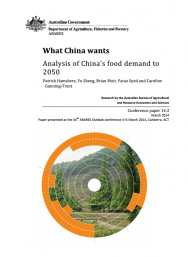
What China Wants: Analysis of China’s food demand to 2050

China’s economic growth and process of urbanisation are bringing about profound changes to China’s agrifood sector. With demand for agrifood products projected to double between 2009 and 2050, China’s agricultural sector is poised to contend with the challenges of depleting natural resource and rising input costs to maintain or improve productivity growth of most
major agricultural commodities.
With the population of China expected to increase to about 1.38 billion in 2050, the nature of food demand will depend on a number of factors, including income growth and urbanization. To investigate these developing trends, this study considers demand across three different income groups: urban high income, urban medium income and rural households. An updated version of the ABARES agrifood model (Linehan et al. 2012a) was used for the analysis. This model is an economic simulation model of global agricultural production, consumption and trade. In this report, agrifood products include primary agricultural products and lightly transformed agricultural products, such as flour and meat, but exclude highly processed food items. While it is projected that the majority of China’s future food demand will be met by an increase in domestic production, there are significant challenges with which the Chinese agrifood sector will need to contend to maintain or increase productivity growth. Investment in the industry is ongoing and required to ensure the degradation and availability of land and water resources, and rising costs for intermediate inputs, do not impede production growth.
The opportunities that Chinese demand growth will provide to food producers and exporters to 2050 are significant. To fully realize those opportunities, it will be important for Australian industries to utilize the working relationships with different agents in the food supply chain in China. For example, supermarkets and hypermarkets, which have an increasing presence in
urban food retailing in China, are playing an important role in meeting the demand for high‐value products by urban consumers. With higher incomes, urban consumers are also expected to increase their expenditure on convenience foods, fast food and restaurant food. Australian industries will need to be responsive to these changes if they are to successfully compete in the
Chinese market over the long term.
- Issues:
- Demography, Urbanization and Migration, Economics, Natural Resources
- Region:
- Asia
- Country:
- China
- Year Published:
- 2014
- Authors:
- Patrick Hamshere, Yu Sheng, Brian Moir, Faraz Syed, Caroline Gunning‐Trant
- Institutions:
- Australian Government, Australian Bureau of Agricultural and Resource Economics and Sciences

